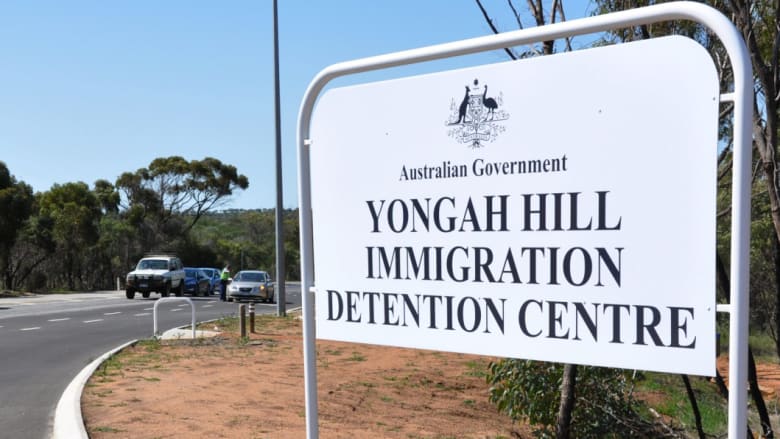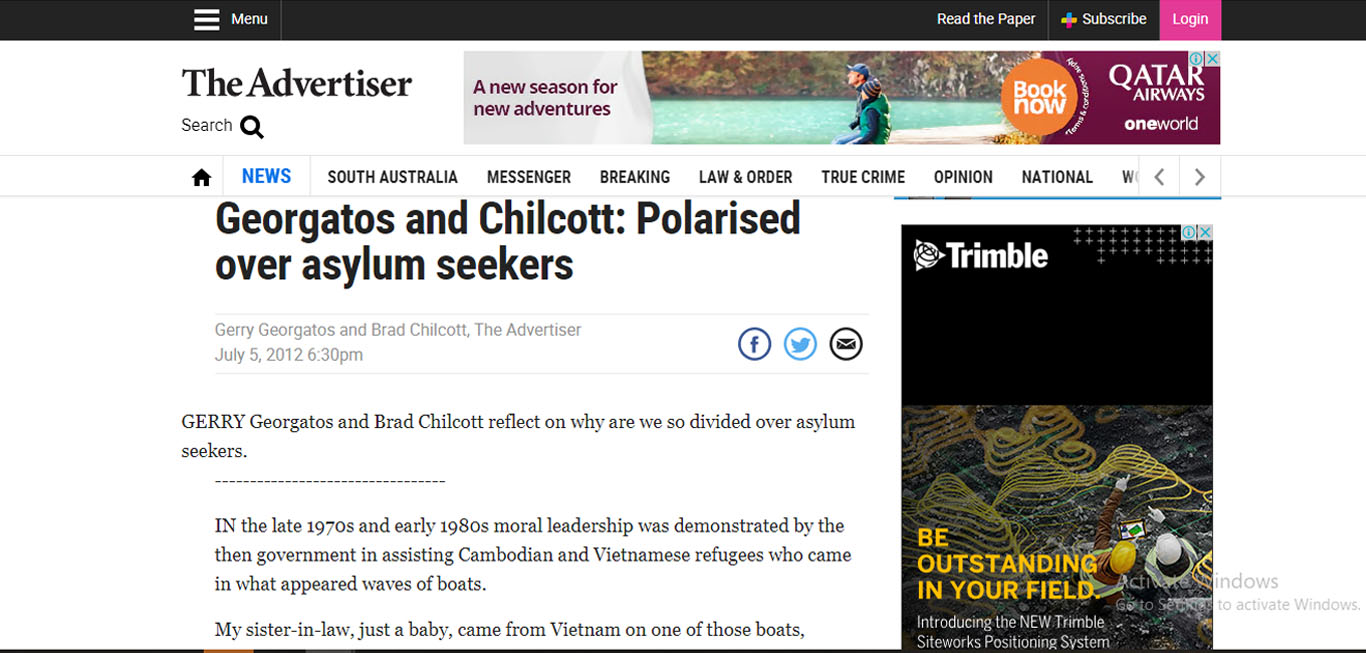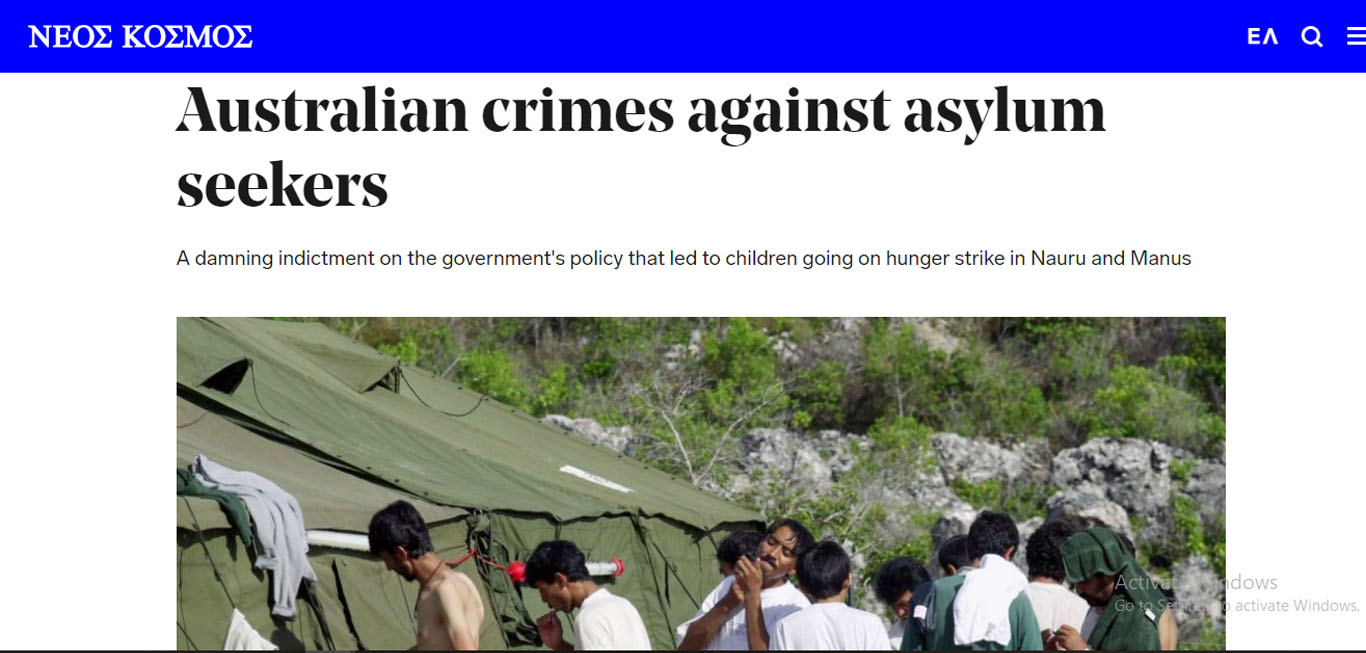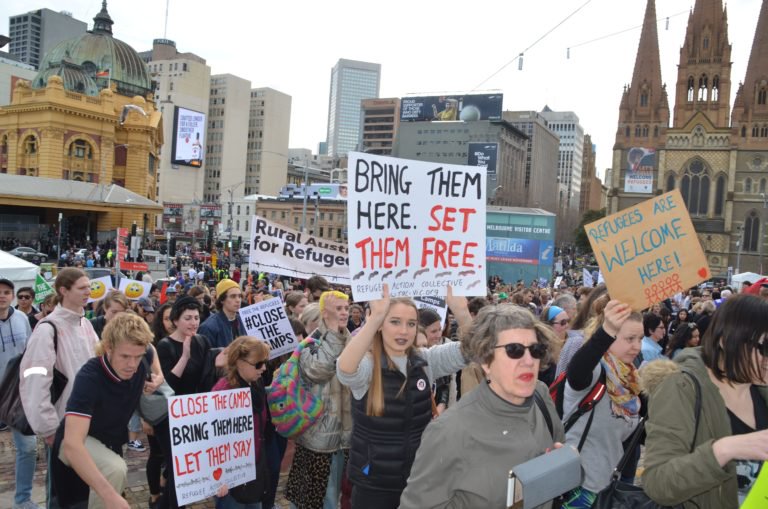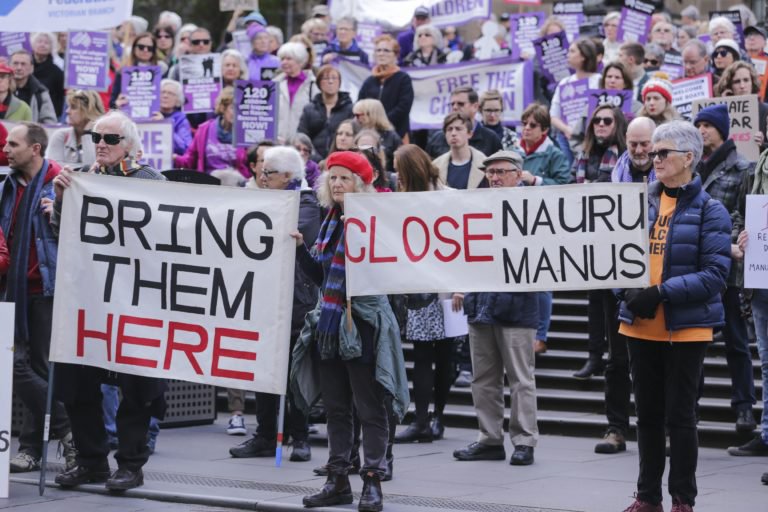Saeed Hassanloo: Death of Iranian asylum seeker prompts calls for more mental health support
12 Sep 2016 ABC NEWS
An Iranian man who sparked nationwide outcry during his 44-day hunger strike last year has become the latest in a number of refugee and asylum seeker suicides in Australia this year.
Saeed Hassanloo started his hunger strike at a West Australian detention centre when he was told his claim for refugee status had been rejected after more than four years in detention.
He was admitted to Royal Perth Hospital in March last year but broke his month-long hunger strike after supporters gathered outside the hospital and held a candlelight vigil for him.
If you or someone you know needs help, call:
- Lifeline on 13 11 14
- Kids Helpline on 1800 551 800
- MensLine Australia on 1300 789 978
- Suicide Call Back Service on 1300 659 467
After leaving hospital, Mr Hassanloo was returned to detention before eventually being let into the community on a bridging visa.
He had been living in Hobart for most of this year, until he took his life a fortnight ago.
According to Monash University’s Australian Border Deaths Database, there have been seven suicides of refugees and asylum seekers living in the Australian community since March last year.
Suicide prevention researcher Gerry Georgatos said he was aware of 12 suicides outside of detention in the past two and a half years.
“This is more suicides outside of detention than within detention and it evidences the irreparable damage to people incarcerated in detention for unjustifiable periods and in conditions much worse than the general Australian prison experience,” he said.
“The individuals coming through immigration detention, having fled various persecutions and various traumas, are at elevated risk once they have been detained for months and years on end.
“For so many to suicide relatively soon after release from immigration detention describes a constancy of traumas and irreparable damage.
“It is evident that former refugees who come through immigration detention are among the nation’s most vulnerable to suicide.”
‘The torture does not end’
Tasmanian Asylum Seeker Support coordinator Helen Semler said she was aware of two suicides, a refugee and an asylum seeker, in Hobart in the past two months.
The other man, who was also Iranian, had been living in Hobart for some years and is believed to have gained permanent protection.
“The torture does not end once they have left detention,” Ms Semler said.
“They can’t settle because there is nothing certain in their lives other than the fact that they are here at the moment. They have not seen their family for years. Some of them have never seen their children.
“I had a [refugee] friend just the other day telling me ‘you know, I think I might be better off dead’.”
‘Lethal hopelessness’ haunts former asylum seekers
Murdoch University Law Associate Professor Mary Anne Kenny said the biggest stressor for most asylum seekers after they leave detention was the uncertainty around their future.
“They do not know whether they will be allowed to remain in Australia or have to return to a country where they fear being persecuted,” Professor Kenny said.
“They also do not know if they are found to be refugees for how long they will be allowed to remain.
“Forced separation from families and loved ones is also a constant concern and worry. These combined factors are leading to a situation my academic colleagues and I are terming ‘lethal hopelessness’.”
Professor Kenny said she had no doubt there would continue to be a pattern of suicides in the community under the current immigration system, due to the difficulty around gaining permanent protection.
“Even if significant services or supports are provided to them, the core issue of uncertainty that is central to the policy will lead to worsening mental decline for a significant number of refugees,” she said.
Mr Hassanloo had been receiving support from the Red Cross while living in Hobart, and acting director Kat Faludi-Ball said his death showed the heightened vulnerability experienced by people seeking asylum.
“Despite all their efforts to make a new life for themselves, the impacts of successive traumas can be incredibly profound and difficult to overcome,” Dr Faludi-Ball said.
“Physical and mental health are major considerations for people who often have pre-existing traumas, which can be compounded during their migration journey along with their experience of detention or prolonged visa uncertainty.
“We work directly with people to connect them to appropriate services that seek to address these issues — including torture and trauma counselling, mental health services and other available supports.”
Greens Immigration spokesman Nick McKim said Australia’s detention regime caused psychological harm.
“When you set up a detention regime that deliberately sets out to cause psychological harm to people you have to be prepared for the fact that those people, some of them, will self-harm and tragically some of them will suicide,” he said.
“And the Australian Government has to wear some of the responsibility for that.”
In a statement, a spokesperson from the Department of Immigration and Border Protection said the department was “aware of the reported death of a former bridging visa holder living in the community in Tasmania”.
“The Department has mental health nurses, counsellors and psychologists based at our immigration detention centres (IDCs) onshore, as well as consulting psychiatrists who attend the centres as required,” the spokesperson said.
“The Nauru and Manus refugee processing centres both have mental health care staff onsite, including mental health nurses, counsellors, torture and trauma counsellors, psychologists and a psychiatrist. There are additional mental health care staff based at the Nauru Settlement clinic.”
Iraqi immigration detainee dies in Perth hospital after suicide attempt
By Hannah Barry
6 September 2018
An Iraqi man who attempted suicide at a WA detention centre has died in hospital.
Saruuan Aljhelie, 22, attempted suicide while detained at Yongah Hill Immigration Detention Centre on Sunday night, sparking a riot that has left much of the facility destroyed.
He was resucitated at the scene and taken to Northam Hospital in a critical condition.
While the riot raged Mr Aljhelie was transported to Royal Perth Hospital where his condition was deemed serious.
It is understood Mr Aljhelie failed to regain consciousness since his attempt and was considered brain dead and placed on life support.
WAtoday understands he died on Wednesday night.
Mr Ajhelie was originally based at Villawood Detention Centre in Sydney with his family before he was separated and taken to Yongah Hill.
His family is currently in Perth and have been at Mr Ajhelie’s bedside.
According to sources, his family will travel to Yongah Hill on Friday morning to collect his belongings.
He is survived by two children, and a report regarding the circumstances of his death will prepared for the coroner.
Refugees who were previously detained at the Yongah Hill facility will be transported to Christmas Island, with 25 of the 54 rooms still standing currently condemned.
National Migrant Youth Support Service national coordinator Gerry Georgatos said the continued detention of those who rioted in the belief Mr Aljhelie had died was yet another indictment of Australia’s immigration policies.
“Relocating people who are asylum seekers and refugees to Christmas Island is a compounding traumatic experience, akin to relocation from one prison to another,” he said
“This will be a significant negative psychosocial hit, with the sense of hopelessness deepened.
“They are at advanced risk to toxic grief, serious depressions, disordered thinking, cognitive narrowing, suicidal ideation, aberrant behaviour.
“Some of them will have spent significant stretches at Christmas Island detention centre and their return will imbue a harrowing sense of the inescapable from a reprehensible predicament.”
If you are experiencing mental health issues contact LifeLine WA on 13 11 14, the Suicide Call Back Service on 1300 659 467, or the MensLine Australia on 1300 789 978.
Language help for refugees in detention
JANE HAMMOND
The West Australian
Wednesday, 9 March 2011
Hundreds of dictionaries covering a variety of languages and dialects are being distributed to asylum seekers in detention centres across WA.
The dictionaries, which provide much-needed assistance to people whose English language skills may be limited, are funded and distributed by volunteers from the Refugee Rights Action Network.
Each bilingual dictionary costs about $30 but all are given away to the detainees.
So far, the group has sourced Tamil, Farsi, Dari and Arabic English dictionaries and distributed them to 450 detainees.
Co-ordinator of the program Sally Woodliff said it was a pity that the dictionaries that had proved useful to so many detainees had to be funded and distributed by volunteers.
Her group had been providing the service for the past six months and had raised $5000 nationally for the program.
Ms Woodliff said detainees at the Curtin detention centre had recently organised their own English language classes and had asked for Oxford picture dictionaries to assist in the classes.
Human rights activist and member of the refugee action group Gerry Georgatos said asylum seekers had the right to be understood and the Department of Immigration should provide basic materials such as bilingual dictionaries.
“Dictionaries, and the right to be understood, are the most basic courtesy,” Mr Georgatos said.
A spokesman for the department said bilingual dictionaries were available in detention centre libraries.
Georgatos and Chilcott: Polarised over asylum seekers
Gerry Georgatos and Brad Chilcott, The Advertiser
July 5, 2012
GERRY Georgatos and Brad Chilcott reflect on why are we so divided over asylum seekers.
———————————
IN the late 1970s and early 1980s moral leadership was demonstrated by the then government in assisting Cambodian and Vietnamese refugees who came in what appeared waves of boats.
My sister-in-law, just a baby, came from Vietnam on one of those boats, which nearly sank.
Children who arrived from these countries without the English language and without possessions came to my school. I became friends with some of them. One of them, a landmine victim, profoundly dragged his right leg.
During this period Andrew Peacock led the way, telling his government he would resign if people fleeing Pol Pot’s Khmer Rouge killing fields were not assisted.
Similar compassionate support from Fred Chaney and Malcolm Fraser ensured adequate humanity.
Mandatory detention was enacted as legislation by the Paul Keating ALP government in 1992 and it raised its ugly spectre a dozen years ago and continues. However, it is not right for people to revise 1980s history and say that asylum seekers were welcomed en masse.
They were not, though their reception was not as unwelcoming as our contemporary one.
There were forms of off-shore processing, or rather regional collaboration, back then, too – at Galang camp in Indonesia and at Hei Ling Chau camp in Hong Kong.
These were places with horrific conditions where people died.
However, there were UNHCR personnel at the camps to assist with resettlement.
Galang Island refugee camp opened in 1979 and was closed in 1996 after all the refugees were resettled. It had two camps – one for newly arrived refugees and another one for those approved, who received English classes and cultural information about the country of their resettlement.
Most of the refugees at Galang preferred Australia for resettlement (and Australia took a significant proportion of them). This was because Australia had shorter waiting periods and less bureaucratic red tape. The US and Canada took in large numbers, too. However, their waiting periods were longer.
Babies were born in Galang and people died there. Alongside the UNHCR, Doctors Without Borders and Save the Children maintained a near daily presence.
Hong Kong’s little rocky island of Hei Ling Chau maintained a closed camp with razor wire. Many of the refugees broke down, many died. However, Hong Kong refused to push boats of refugees back out to sea, as on occasion the Thais did.
As a refugee advocate, I strongly oppose mandatory detention and the Kafkaesque ASIO “security” clearances of asylum seekers who are being brutalised by the traumatic waiting periods.
However, it was wrong for all three major parties in Parliament to fail to break the latest impasse. The Coalition deserves some respite because they appeared, for whatever reasons, to have made some urgent concessions. None of these parliamentarians or their families were linked to the near 600 Australia-bound asylum seekers who have drowned since 2007.
I understand what the Australian Greens are arguing for, but when you can’t secure sweeping changes then you go for what you can get when people’s lives are on the line.
The Greens should have accepted the Coalition’s offer of a near-doubling of resettlement numbers – to 26,000 – and a multi-party forum … and even Nauru and Manus if need be.
It is to the ALP’s great shame that those I know in the party – Melissa Parke, Louise Pratt, Anne Burke and others – did not cross the floor.
I am a PhD law researcher in Australian custodial systems and I have interviewed hundreds of people who have been in prisons and in immigration detention. They come out of these centres worse off.
However, there is no point grandstanding in a bid to reach the high moral ground, which generally I fight for, if the justice we need is not going to be done and if people are going to drown.
Parliament should have taken up Tony Abbott’s offer. Malaysia should not be an option. The Rob Oakeshott Bill is draconian and worse than John Howard’s Pacific Solution and it will solve nothing.
The current political landscape is damaging the national consciousness – our governments have created the problems that have eroded human compassion.
On average, only 56 refugees a year over 10 years have been resettled in Australia from Indonesia.
There are only 13,500 refugees on annual resettlement quotas.
From the beginning of this year until the end of May, only 24 refugees have been resettled from Indonesia to Australia.
That is from a pool of 5732 available places for asylum seekers and refugees.
There are only 4239 asylum seekers at this time in all of Indonesia – this is not an insurmountable number for us to assist and in so doing save lives.
Gerry Georgatos is a researcher, refugee advocate and Human Rights Alliance spokesperson.
Australian crimes against asylum seekers
A damning indictment on the government’s policy that led to children going on hunger strike in Nauru and Manus
Gerry Georgatos
7 September 2018
Future gemerations will damn the present for its atrocities, as we damn and indict the past for theirs. The offshore custodial predicaments that have degenerated to indefinite immigration detention will cast a dark pall of grimness and aspersions into the generations of our grandchildren.
As a trauma recovery and suicide prevention researcher and as someone who has supported families who have been resettled as refugees after years in immigration detention, I have been close up to the psychological and psychosocial impacts of compounding traumas, witness to cognitive and dialectic narrowing and other damage from cumulative composite and aggressive traumas of which, for some, are near irreparable.
The Australian nation is increasingly availed to the corral of deprivations, miseries and sufferings that are its immigration detention crudely syphoned off to Nauru and Manus. The rudderless, brutal spectacle is at least forever in the public eye. There are the harrowing tragic unnatural deaths — half and quarter lives, suicides, attempted suicides, the hunger striking, children less than half normal body weight.
The unjustifiable languishing of people who once hoped for a persecution-free life, who rode dangerous high seas in crowded unseaworthy boats on average for three weeks has been abominably greeted with years in detention. The Australia in which we should be living is one that should be welcoming asylum seekers, resettling humanity and not railing against it.
There are more suicides outside of detention than within it, evidencing irreparable damage to people who had been incarcerated for unjustifiable periods. I visit the insides of prisons and support people pre and post-release and, in my view, in general people come out of the prison experience in a worse state than when they went in. In my experience, conditions in immigration detention are worse than Australian prisons.
People who have suffered long stretches in immigration detention are at elevated risk to anxiety, depression, agoraphobia and suicidal ideation.
I remember a young man who, after six years in immigration detention, took his life nine months after having been released. It is evident that former refugees who have come through the Kafkaesque immigration detention system are among the nation’s most vulnerable to suicide.
Monash University’s Australian Border Deaths Database recorded seven suicides of former refugees and asylum seekers outside of immigration detention facilities from March 2015 to September 2016. In two-and-a-half years to September 2016, there were 12 suicides. For every suicide, be assured there are at least 20 attempted suicides, scores of people chronically seriously depressed. For so many to die by suicide relatively soon after release from immigration detention describes a constancy of traumas and irreparable damage.
Each of these suicides of resettled former refugees should have stirred the nation.
HOW AUSTRALIA FAILED SAEED HASSANLOO
In September 2016, 26-year-old Saeed Hassanloo, nine months after being released after six years in immigration detention took his life in Hobart. In the last days of February 2015, Saeed began a hunger strike at Yongah Hill Detention Centre in Northam, Western Australia. For 35 days the Department of Immigration sickeningly kept his hunger strike a secret, isolating him at Yongah Hill.
At the 35th day of his hunger striking, Saeed was admitted to Royal Perth Hospital. Some of Perth’s humanity gathered every night outside the hospital with candlelight vigils. Flowers filled his room. Saeed’s will to live was galvanised by the concern and love by so many, that many Australians truly do care and that our Governments are not reflective of the demography of this nation. On the 44th day of attempting suicide by starvation, Saeed consumed fluids.
In the preceding days, I had contacted the office of the Immigration Minister, Peter Dutton. A staffer told me that Saeed Hassanloo had passed away. Australia’s first hunger strike death.
I soon realised the staffer had assumed he’d died when he hadn’t. Reprehensibly, the Office of Immigration had consigned themselves to the death by starvation of Saeed Hassanloo. The Office had prepared a media statement on what they believed would be the inevitability of Saeed’s passing. The staffer I talked to during his morning brief had skimmed through the death statement and assumed Saeed’s death.
What sort of leadership is this? They were prepared to let a young man die in an Australian hospital.
Minister Dutton almost became Prime Minister, failing by only 13 votes. Is this who the Australian nation would want as their Prime Minister?
Saeed was returned to Yongah Hill and, months later, we succeeded with his refugee status — more than six years after his arrival at Christmas Island at 19 years of age. However, trauma haunted him until he took his life. The levels of self-harming and breakdowns in immigration detention should have long ago galvanised alternatives to detention.
What sort of Australia allows for children to be detained for years, for a 12-year-old boy hunger striking on Nauru, emaciated by starvation to 36 kilograms?
The mental deterioration of this child is a political and moral abomination.
That 119 children who remain on Nauru is a damning of the Australian nation. Children as young as nine and ten have attempted suicide, attempted self-immolation.
THE HISTORY OF MANDATORY DETENTION
In the late 1970s and early 1980s, moral leadership was demonstrated by the Government in assisting Cambodian and Vietnamese refugees who came in what appeared waves of boats.
My sister-in-law, just a baby, came from Vietnam in one of those boats, which nearly sank.
Children who arrived from these countries without the English language and without possessions came to my school. I became friends with some of them. One of them, a landmine victim, profoundly dragged his right leg. During this period, Andrew Peacock led the way, telling his Government he would resign if people fleeing Pol Pot’s Khmer Rouge killing fields were not assisted.
Similar compassionate support from Fred Chaney and Malcolm Fraser ensured at least rudimentary humanity.
Mandatory detention, though not originally intended as indefinite, was enacted as legislation by Gerry Hand and Paul Keating in 1992.
The 1980s did not welcome the asylum seekers, but strong leadership stood taller. This ensured that asylum seekers and refugees did not receive the unwelcoming and ugly receptions of the last near two decades.
There were forms of offshore processing, or rather regional collaboration, at Galang camp in Indonesia and at Hei Ling Chau camp in Hong Kong.
These were places with horrific conditions where people died. However, there was UNHCR personnel at the camps to assist with resettlement.
Galang Island refugee camp opened in 1979 and was closed in 1996 after all the refugees were resettled. It had two camps; one for newly arrived refugees and another one for those approved, who received English classes and cultural information about the country of their resettlement.
In those 17 years, 400,000 asylum seekers were resettled. Australia quietly agreed to 40,000 but in the end accepted 70,000. Refugees at Galang preferred Australia. This was because Australia had shorter waiting periods, less bureaucratic red tape and faster processing.
Babies were born in Galang and people died there. Alongside the UNHCR, Doctors Without Borders and Save the Children maintained a near-daily presence.
Hong Kong’s little rocky island of Hei Ling Chau maintained a closed camp with razor wire. Many of the refugees broke down, many died. However, Hong Kong refused to push boats of refugees back out to sea, as on occasion the Thais did.
White-knuckled racism today grips the Australian landscape tighter than at any time in the last half-century.
Inhumanity towards refugees has never been more palpable.
The Australian Government could have closed Nauru and Manus and freed the refugees to New Zealand.
When a 12-year-old child hunger strikes, this bespeaks of the bleak, of no beacon of light, of hopes extinguished.




